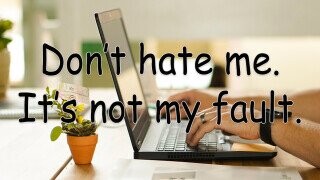Comic Sans Doesn't Deserve Your Hate

You've heard of using Comic Sans on a resume at your own risk, as it has been deemed inappropriate on so many levels of the "professional" world. Meanwhile, Helvetica is hanging out in the back, laughing in its most pretentious manner. The very thought of selecting this font is often demonized? Even its inventor has admitted that he has only ever used it once -- in a friendly email asking for a refund (and it managed to get his money back). So before you hate, please appreciate that Comic Sans has done some good for someone in this world already.
It's for elementary-level children, and that was its purpose, explains Vincent Connare, the designer behind the often referred to as "most hated font in the world." In an interview, Connare revealed that he created Comic Sans in 1995 for Microsoft upon noticing a peculiarity with a software product he had been working with known as Microsoft Bob. The goal was to ease children into using computers by having things like a friendly animated dog helped guide them. (Again, this was 1995.)
Connare says that problem was that the dog's welcoming speech bubble, written exclusively in the very serious Times New Roman, failed miserably at conveying a casual message to children. Naturally, he declared that "dogs don't really talk like that." To make the message more fun, he suggested the creation of a new font, one that would mimic the lettering found in comic books rather than a British newspaper.
Don't Miss
His goal was never to be correct or perfect, and it shows, as Connare hand drew each curvature and line in every letter with a cursor. It is apparent here, in the letter "n":

Notice that a very experienced designer of over 26 years is said to have come up with this lettering, even though the shakiness and awkward curve bending the letter out resembles that of a competent kindergartner attempting to spell out their name. Still, this would change the face of font designing forever.
It was only a matter of time before the font gained attention, as the team started using it when sending bubbly emails, later releasing it with Windows 95. On Connare's website, he states that "There was no intention to include the font in other applications other than those designed for children … The inspiration came at the shock of seeing Times New Roman used in an inappropriate way."
After hitting the general public, bizarrely passionate Comic Sans haters started to make themselves known. "Knock yourselves out," said Connare in response to two dedicated dislikers who, in 2002, kindly asked if they could start a movement against his work, Ban Comic Sans. (Hey, at least they asked.)
But the heavy, ultra-specific criticism didn't stop there. In fact, most opinions about how inefficient Comic Sans tend to be more detailed than sad Star Wars' Wikis. One article written by web designer David Kadavy goes on about how "This mismanagement of visual weight is the main issue that makes reading Comic Sans an unpleasant experience. Evenness of weight, or "texture" is important to the legibility and readability of typography. Letters or blocks of text that are free from disproportionately light or heavy spots allow the letterforms themselves to shine through and be read easily."
Why all the hatred when the font serves more than just an aesthetic experience? Connare agrees that "typography should not shout, but Comic Sans shouts." He states that he is proud of his work and although the rules of typography have been broken by Connare, one being that the letters don't mirror each other, such as "p" and "q," the manner in which the letters appear have been proven to make it easier for people with reading difficulties. The spacing of the letters allows for a smoother viewing experience, particularly for those with dyslexia.
The "problem" with the font isn't the font. It's the misuse of it. You wouldn't use a sword to peel an orange, just like you wouldn't drop that font in a doctoral thesis. There is a time and a place for Comic Sans, and it usually lies somewhere in between a promotional spring clothing sale banner and a child's bouncy house birthday party.
Top Image: meminsito/Pixabay